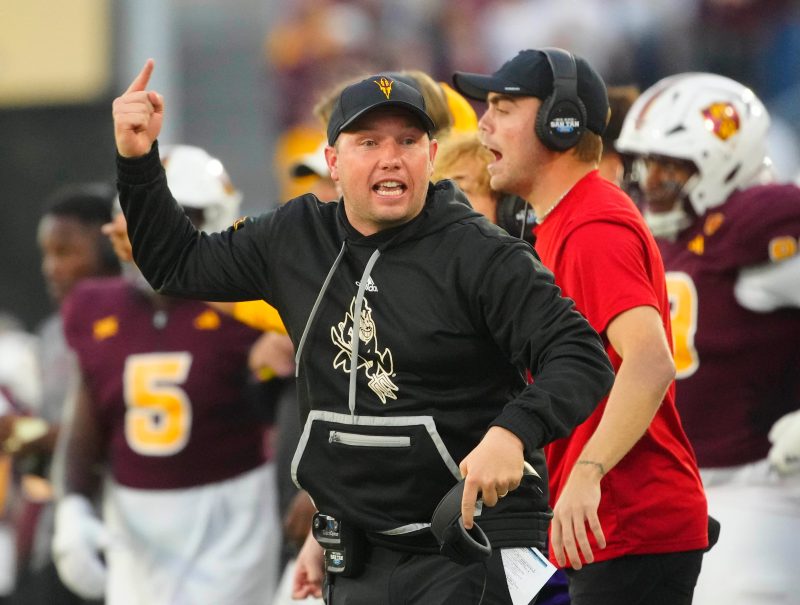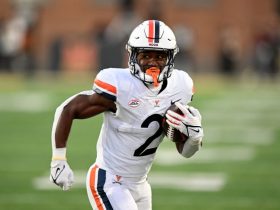ATLANTA — It all lined up perfectly, the 32-year-old wunderkind taking over the program he knew inside and out, returning to the metropolitan area where he was born and raised, fulfilling his lifelong goal of becoming a head coach before most of his peers had even gotten their careers off the ground.
But besides the paycheck, there were reasons to be skeptical about the task Kenny Dillingham was signing up for. Despite his relative inexperience and unbridled ambition, Dillingham knew the drill when it came to Arizona State football: Decades of unfulfilled potential, challenges getting the local community to support college sports in a pro-dominated market and the potential for NCAA penalties thanks to the mismanagement of his predecessor, Herm Edwards.
If it didn’t work, Dillingham’s aspirations were probably not going to end up the way he envisioned,
“Usually you only get one opportunity to be a head coach,” Dillingham said. “When we took over, it was in a different place. I knew it was going to be difficult.”
Instead, the youngest coach in FBS has made it look easy.
On Wednesday afternoon, Arizona State — a 3-9 team just one year ago, picked to finish last in the Big 12 six months ago — will take the field against Texas in the College Football Playoff quarterfinals.
Forget the fact that Arizona State is the biggest underdog in any of the remaining playoff matchups. Forget that this program hasn’t finished a season in the top 10 since 1996. Forget that Dillingham was a graduate assistant at Memphis a mere eight years ago while his counterpart, Steve Sarkisian, has a résumé that took him from one blue blood (Southern California) to another (Alabama) to yet one more (Texas) with a two-year NFL stint in between.
EXPERT PICKS: Who wins Fiesta Bowl between Penn State, Boise State?
TUESDAY SCHEDULE: Breaking down the five bowls on New Year’s Eve
In a college football era defined by disruption, where season by season fortunes hinge on fine margins and a program’s relationship with its players feels more transactional than organic, Arizona State is here to show us what’s possible. And Dillingham is here to show us that the new normal doesn’t have to be so bad.
“He just makes it about the players,” defensive coordinator Brian Ward said. “It’s not the top-down model, the hierarchy that’s always been college football. I think a lot of people have a hard time adjusting and adapting. Kenny is different.”
These are cynical times for college sports. When coaches aren’t complaining publicly about the recruiting environment or the transfer portal, most of them are doing it privately. Every time a coach walks away, even if they’re at the typical retirement age, it seems like a referendum on the industry’s struggle to manage name, image and likeness rules in an orderly manner. The NCAA seems feckless, unable to enforce its rules while it waits to be rescued by Congress. Even expanding the College Football Playoff to 12 teams has created detractors nitpicking the teams that were selected or the competitiveness of the first-round games a little more than a week ago.
But at the end of the day, what’s better for the sport: the same five or six programs dominating everything, or a perennial mediocrity like Arizona State finally getting it right and being rewarded with relevance and hope?
It’s an easy answer. Yes, college football needs the gravitas of its Texases and Ohio States. But for far too long, the Arizona States didn’t really have a place in this sport barring a massive, once-a-century type of fluke.
Even a year ago, Arizona State would have gotten a pat on the head and a cool bowl trip for going 11-2 and winning the Big 12. That would have been a nice reward for the players, but it’s not validation. The new CFP has shown that every school is one good hire and a nice run in the transfer portal away from getting its chance to compete for a national title, even as unlikely as that might be.
And were not talking about Little Sisters of the Poor here. Arizona State has 57,000 in-person undergrads, sits adjacent to a top-15 media market and has one of the most attractive on-campus setups in the country when you consider the weather and scenery.
If *that* school is doomed to be shut out of college football’s spoils because of decades-long structural disadvantages, you’re not maximizing what the sport can be and how it can touch all corners of the country.
It’s uncertain what this run means for the future of Arizona State. But at least there’s a chance to ignite something that for too long felt unattainable — even for someone like Dillingham who went to high school half an hour from campus.
“We compete against teams and fan bases that are obsessive,” Dillingham said. “We have to become an obsessive fan base, and if we can do that in (one of the largest cities) in the country where people go to retire, you’ve got something special. People have to see the joy, see the excitement. They have to see there’s no difference between winning for the city and how it creates winning for the local businesses and what winning does for a player when they reap benefits and are top-five in the Heisman vote. Everybody wins when you win, so why not get the entire state, the entire city behind a winner?”
And with Dillingham, you’re not going to have to search hard for the emotional connection. He cries in front of players. Sometimes he loses his cool and turns into an Internet meme. He simultaneously makes you believe he belongs in the upper echelon of college coaches while conveying a sense that there’s a true generational shift underway from the Nick Saban types to the Millennials like Dillingham or Notre Dame’s Marcus Freeman who are now starting to get these jobs.
That sense of inexperience and lack of seriousness — whether fair or not — has forever been the most significant barrier in college football for younger coaches. But as the sport’s longtime standard bearers find frustration in the sport’s new culture where relationships are year-to-year and there are no rules binding players to programs, youth may be an asset.
“Intuition and thinking outside the box in this era is important, and he doesn’t have years of experience that ‘This is how I’ve always done it as a head coach,’” said Sarkisian, who was 35 when he took over his first head coaching job at Washington. “He has a little more of a blank canvas that he can shape in terms of how to manage the portal, manage NIL, manage conference realignment.
“I look back on it when I was 34 thinking, I didn’t know what the heck I was doing. But I had a ton of energy back then, and Kenny does too. The rapport with players is always helpful when you’re a little younger, and that energy is needed when you’re struggling in Year 1 so I have a ton of respect for the job he’s done.”
Energy is a word you’ll hear a lot around Dillingham, but it’s not just staying up late to make recruiting phone calls or doing a lot of interviews to give the appearance of working hard. More important is the locker room energy that he seeks when bringing people into the program. If a recruit doesn’t respond to his extroverted personality— or isn’t going to match his energy, as the kids say — it’s just not going to work.
“He’s all about getting good people at our place,” said Hines Ward, the longtime Pittsburgh Steelers standout who joined Dillingham’s staff this year as receivers coach. “We’re not going to beg kids to come to Arizona State. We’re going to get kids that want to be a part of our program, that wants to get development and be a part of something special we’re building. It’s made it fun.”
It’s always hard to know exactly what goes on behind closed doors in a football program, but it was notable that within a couple days of winning the Big 12 title Dillingham’s social media feed was amplifying announcements of Arizona State players who entered the transfer portal along with message of support like:
“Fired up to keep coaching you through the bowl/playoff!” he wrote about safety Kamari Wilson.
“Baller! He can flat out help somebody!” he wrote about receiver Kaleb Black.
Dillingham didn’t have to do that — not many coaches do. But in his mind, players shouldn’t have to choose between getting a better opportunity somewhere else and missing out on a potential once-in-a-lifetime experience.
Without everyone’s contributions from the starting quarterback to the scout team, Arizona State isn’t here. So where others complain, Dillingham adapts.
But in the end, he insists what’s happened for the Sun Devils isn’t because he’s some genius. This may not have even happened at a different school, he said, where he doesn’t have the same history and institutional knowledge of the unique circumstances surrounding Arizona State.
But now they’re here, getting ready to play a game that would have seemed impossible a couple years ago. Now the future looks limitless, and maybe Arizona State won’t even need to wait to ascend another level.
That’s what the 12-team College Football Playoff has done. And that’s what Dillingham’s infectious personality has gotten the Sun Devils to believe.
“There’s no doubt we’re playing with house money,” he said. ‘Nobody expected us to be here. But our guys got to this point because they’re ultra competitors. I get asked all the time, ‘Have you reflected?’ No, I haven’t reflected. Right now it’s about doing whatever we can to be the best version of us today, tomorrow and the next day. But eventually I’ll probably look back and be like holy cow, look what we just did.’






